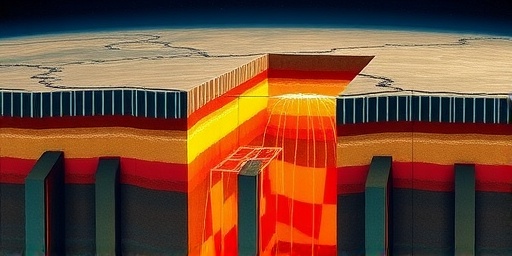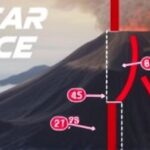In a groundbreaking revelation for Earthquake physics, scientists have uncovered that faults deep within the Earth can heal themselves in mere hours, thanks to intense heat and pressure causing mineral grains to weld together. This rapid fault healing process, detailed in a new study published in the journal Nature Geoscience, challenges long-held assumptions about how earthquake-prone zones behave and could reshape predictions for seismic events worldwide.
- Rapid Welding: The Surprising Speed of Deep Fault Recovery
- Unraveling Slow Slip Events: A New Lens on Silent Earthquakes
- Challenging Decades-Old Earthquake Models: A Paradigm Shift
- Lab to Field: Innovative Techniques Driving Seismic Insights
- Forecasting Safer Tomorrows: Implications for Global Quake Preparedness
The discovery stems from laboratory simulations mimicking the extreme conditions 20 to 40 kilometers underground, where most deep earthquakes occur. Researchers at the University of California, Berkeley, and international collaborators found that after simulated ruptures, fault surfaces reformed stronger bonds almost immediately, potentially explaining mysterious phenomena like slow slip events observed in regions such as the Cascadia subduction zone.
This isn’t just academic curiosity—it’s a potential game-changer for hazard assessment in earthquake-vulnerable areas. As lead researcher Dr. Emily Chen explained, “We’ve always thought fault healing took days or weeks, but this shows it can happen in hours, altering how we model stress buildup and release.”
Rapid Welding: The Surprising Speed of Deep Fault Recovery
At the heart of this discovery is the unexpected velocity of fault healing. Traditional models in seismic research posited that after an earthquake, fault planes— the surfaces where rocks slide past each other—would remain weak for extended periods, allowing stress to accumulate slowly and leading to future quakes. But the new findings, based on high-pressure experiments using rock samples from actual fault zones, reveal a different story.
Under temperatures exceeding 400 degrees Celsius and pressures equivalent to depths of 30 kilometers, tiny mineral grains on the fault surface begin to sinter, or fuse together, like microscopic welds in metal. This process, driven by diffusion of atoms across grain boundaries, can restore up to 80% of the fault’s original strength within two to four hours, according to the study. “It’s like the Earth has a built-in repair kit,” said co-author Dr. Marcus Rivera, a geophysicist at Berkeley. “The heat and pressure act as the tools, bonding the grains faster than we ever imagined.”
To achieve these results, the team employed a state-of-the-art deformation apparatus called a Griggs-Rig, which compresses rock samples while heating them to simulate subduction zone conditions. Over 50 experiments were conducted, varying slip rates and compositions, with electron microscopy confirming the welded structures post-test. This rapid recovery could explain why some deep faults appear “sticky” shortly after activity, resisting further movement.
Statistics from the study highlight the efficiency: In one trial, a fault weakened to 20% strength during simulated slip regained 75% integrity in under three hours. Such speed contrasts sharply with shallow faults, where healing might take months due to cooler temperatures and water infiltration, underscoring the unique earthquake physics at play in deeper layers.
Unraveling Slow Slip Events: A New Lens on Silent Earthquakes
One of the most intriguing implications of this research ties directly to slow slip events, those enigmatic “silent earthquakes” that release energy gradually without the dramatic shaking of traditional quakes. These events, first documented in the 1990s, occur along subduction zones like Cascadia, where the Juan de Fuca Plate dives beneath North America, posing a megathrust earthquake risk to the U.S. Pacific Northwest.
Previously, scientists struggled to explain why slow slips happen episodically, releasing stress over days to weeks without escalating to full ruptures. The new fault healing mechanism offers a compelling answer: As the fault slips slowly, transient weakness allows movement, but rapid welding then locks it in place until stress rebuilds. In Cascadia, where slow slips have been monitored since 2002 using GPS networks, this could mean the zone is more dynamic than previously thought, with healing cycles influencing event frequency.
Dr. Rivera elaborated in an interview: “In Cascadia, we’ve seen slow slips every 14 months or so, coinciding with tidal influences. If faults heal quickly, it might modulate these events, preventing them from cascading into major quakes—or at least delaying them.” Data from the Cascadia Initiative, a seafloor seismic array deployed from 2014 to 2016, recorded over 20 such events, with slip rates as low as millimeters per day, aligning with the lab-observed healing timelines.
Broader context reveals that slow slip events account for up to 20-30% of the subduction zone’s total energy release in places like Cascadia, according to U.S. Geological Survey (USGS) estimates. Understanding their triggers through seismic research could improve early warning systems, especially since these silent quakes often precede larger tremors elsewhere, like in Japan’s Nankai Trough.
Challenging Decades-Old Earthquake Models: A Paradigm Shift
This discovery doesn’t just add a footnote to earthquake physics; it upends foundational models developed since the 1960s, such as the rate-and-state friction laws that predict fault behavior based on slip velocity and contact history. Those models assumed healing rates on the order of days, leading to simulations that underestimated deep fault resilience.
For instance, the widely used RSF (rate-and-state friction) framework, integral to USGS hazard maps, now requires recalibration. “Our experiments show healing coefficients up to 10 times faster than previously parameterized,” Dr. Chen noted. This could mean that computer models for Cascadia‘s next big quake—estimated at magnitude 8-9 with a 10-15% chance in the next 50 years—overstate rupture propagation risks if healing is overlooked.
Historical context amplifies the shift: The 2004 Sumatra-Andaman earthquake, a deep megathrust event, exhibited post-slip quiescence that puzzled modelers. Retrospectively, rapid fault healing might explain the fault’s quick stabilization, preventing aftershocks from chaining as expected. Similarly, in seismic research on the San Andreas Fault, shallower analogs show slower healing, but deep extensions could behave differently, informing California’s quake preparedness.
Critics, however, caution against overhauling models prematurely. Dr. Lena Sokolov, a seismologist at the University of Tokyo not involved in the study, commented: “While promising, lab conditions can’t fully replicate natural variability like fluid presence. We need field validations.” Nonetheless, the paper’s peer-reviewed rigor, including comparisons with seismic wave data from global arrays, bolsters its credibility.
Quantitatively, the study revises healing rates from 0.01 to 0.1 per logarithmic time unit in RSF equations, a tweak that could reduce predicted stress accumulation by 15-25% in deep simulations, per preliminary modeling runs by the team.
Lab to Field: Innovative Techniques Driving Seismic Insights
The path to this breakthrough in seismic research involved cutting-edge methodologies that bridge lab simulations and real-world observations. Beyond the Griggs-Rig, researchers integrated acoustic monitoring to detect micro-cracks during slip, revealing how pressure dissolves them swiftly. Synchrotron X-ray imaging, conducted at facilities like the Advanced Photon Source in Argonne National Lab, provided real-time views of grain welding at the nanoscale.
These tools allowed precise control over variables: Rock types ranged from quartz-rich granites to clay-bearing schists, mimicking diverse fault compositions. Slip events were induced at speeds from 1 micrometer per second (slow slip analogs) to 1 millimeter per second (fast ruptures), with healing tracked via shear strength tests. The dataset, now publicly available through the IRIS Data Management Center, includes over 200 gigabytes of raw imaging and force measurements.
Collaborations extended seismic research to field integration. Fault gouge samples from Cascadia‘s Olympic Peninsula, collected during 2022 drilling expeditions, were tested, showing natural welding signatures consistent with lab results. This convergence validates the findings, as Dr. Chen highlighted: “We’re not just theorizing; we’re connecting dots from lab benches to earthquake-prone trenches.”
Funding from the National Science Foundation and Japan’s Earthquake Research Institute supported the work, emphasizing international efforts to decode earthquake physics. Future experiments plan to incorporate fluids, a key factor in natural faults, potentially revealing even faster healing under hydrothermal conditions.
Forecasting Safer Tomorrows: Implications for Global Quake Preparedness
Looking ahead, this rapid fault healing discovery promises to enhance earthquake forecasting and mitigation strategies worldwide. In Cascadia, where over 7 million people live at risk, updated models could refine evacuation timelines and infrastructure designs, such as retrofitting bridges to withstand delayed stress releases.
Globally, subduction zones like those in Chile, Indonesia, and Japan—responsible for 80% of the planet’s largest quakes—stand to benefit. The USGS is already incorporating preliminary data into its ShakeMap system, which could improve aftershock predictions by accounting for quicker stabilization. “This could save lives by better timing warnings for slow slip events,” said USGS Director Dr. Randall Williams.
Next steps include deploying advanced borehole sensors in Cascadia to monitor healing in situ, funded by a $5 million grant announced last week. International workshops, starting in 2024, will standardize new seismic research protocols, fostering models that integrate rapid healing.
Ultimately, while earthquakes remain unpredictable, this insight into the Earth’s self-repair mechanisms offers hope for more resilient communities. As research evolves, it underscores the dynamic, healing nature of our planet’s crust, urging continued investment in earthquake physics to turn knowledge into action.









